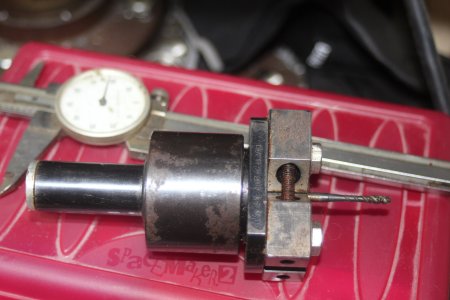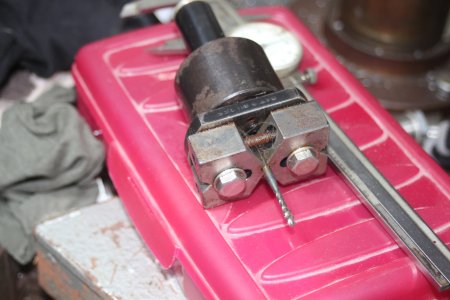I have the “Synchronizer” from Shars in ER16. I’ve done about 1000+ holes #8 to 5/16” - very happy with the results (except for the time I didn’t drill a hole first, that did not end well - there is a story there that I don’t feel like sharing).
Interested in adjusting the advance rate to slightly below the thread pitch lead? What does it gain - a little better surface finish, maybe some forgiveness on the bottom hole reversal (keep everything in tension)?
The problem with my Tormach is that the spindle RPMs on the controller display is not 100% accurate; it doesn't have an encoder that measures actual speed. I've never adjusted it, there is a pot on the VFD of my Tormach where the RPMs can be adjusted. It can be done with a Hall-effect tach on the spindle; adjust the VFD so the Hall-effect tach matches the controller's indicated RPMs.
I'm thinking (scary) that the Z-axis feed should be slightly faster than the spindle speed so the tapping head compresses slightly as the tap advances. If the Z-axis feed is too slow, the spindle would be turning the tap faster than the Z-axis feed; the tap would advance at a rate faster than the head possibly pulling it out the the chuck or snapping the tap (?). The Tormach head has about 1/4" of travel in compression; going too fast in Z "should" result in the head compressing as it's designed to do.
This is a snippet of Tormach's instructions:

Using their example, a 1/4-20 tap running at 500 RPM would need a feed rate of 25 IPM (500 / 20); feed rate = spindle RPM / tpi. The concern is that my machine may say the spindle is at 500 RPMs, but it may be 450 or 550 since there's no encoder/tach built into the machine. If my spindle was turning at 550 RPM, the feed rate should be 27.5 IPM (550 / 20). I'm thinking (again, scary) that it'd be prudent to go slightly higher on the Z-axis feed than the calculation to compensate for inaccuracy in the spindle RPM. If I were going to use the head, I'd do the procedure in the Tormach manual for adjusting the VFD pot to get as close as possible to the spindle speed at which I'd be running the tapping head.
If I'm correct in my thinking (all theory, no experience), a slightly high Z-axis feed rate would mean that the head is compressed during tapping. The Tormach head has about 1/4" of compressive travel, so there's a little wiggle room depending on the depth of the tapped hole.
Anyway, don't take anything I said as the gospel; it's my understanding of how it works with no experience.



 I would always program the feed rate as the thread pitch minus .001 per rev though . Seems as though they tie the feedrate to the rpm .
I would always program the feed rate as the thread pitch minus .001 per rev though . Seems as though they tie the feedrate to the rpm .


 Come on , spill the beans !!!! Believe me , I could tell some stories also .
Come on , spill the beans !!!! Believe me , I could tell some stories also .